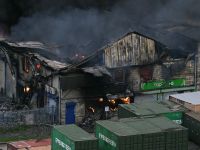DataString Consulting Releases Middle East Movable Heavy Machinery Industry Outlook, 2025

The global Movable Heavy Machinery industry is entering a pivotal stage in its development, with emerging economies, sustainability priorities, and technological upgrades reshaping competitive dynamics. According to DataString Consulting’s latest industry assessment, global revenues reached nearly USD 739.4 billion in 2024, supported by construction, mining, agriculture, logistics, and energy value chains. While Asia Pacific currently dominates global demand, the Middle East is rapidly gaining prominence due to its state-driven development programs, diversification agendas, and large-scale infrastructure pipelines.
This press release outlines how the regional market is evolving in comparison to global trajectories, reflecting DataString Consulting’s ongoing focus on high quality advisory for the energy, infrastructure, and industrial sectors.
Global Industry Transitions Toward Digital and Sustainable Machinery
The global industry is transitioning from traditional mechanization to a digitally integrated ecosystem where automation, telematics, predictive maintenance, electric fleets, and hybrid equipment are becoming standard. In parallel, long-term growth is being propelled by urbanization, mining expansion, agricultural modernization, and structural shifts linked to energy transition. Global market value is projected to reach USD 1.3 trillion by 2035, with sustainability and smart machinery forming the next competitive frontier.
Middle East Emerges as the Fastest-Growing Strategic Machinery Hub
Against this worldwide backdrop, the Middle East is strengthening its role as one of the most transformative markets. Regional governments continue to accelerate capital projects under long term national visions. Saudi Arabia, UAE, and Qatar are expanding multi sector infrastructure aligned with modern urban development, energy diversification, advanced manufacturing, tourism, and logistics. These programs directly increase demand for earthmoving, lifting, tunneling, transport, and specialized machinery used across large construction sites, industrial zones, and mega city developments. DataString Consulting highlights that the Middle East accounts for nearly half of the broader MEA machinery demand and is positioned to outpace global growth rates over the next decade.
Global project benchmarks underscore the region’s momentum. For instance, while China remains the world’s largest buyer of heavy machinery due to its large infrastructure investments and mining activities, the Middle East is creating equally ambitious development clusters. The NEOM program in Saudi Arabia exemplifies this shift, with THE LINE requiring advanced excavation capacities, precision assembly systems, and next generation material handling tools that align with global smart city engineering standards. Similar machinery intensive projects include Abu Dhabi’s Economic Vision initiatives, Dubai’s 2040 Urban Master Plan, and Qatar’s industrial diversification efforts.
Regional Market Structure Distinguishes Middle East from Global Peers
The Middle East market diverges from global norms in several structural areas. Unlike North America and Europe, where aging fleets and regulatory compliance are major drivers, Middle East demand is driven by greenfield construction, integrated industrial cities, and energy infrastructure. Unlike APAC, where demand is dispersed across thousands of small and medium scale projects, Middle East growth is concentrated in large sovereign funded programs with high capital intensity. This concentration creates strong business opportunities for global OEMs that offer advanced technologies and lifecycle service models.
Supply Chain Resilience Strengthens Middle East Equipment Deployment
While global challenges persist, including raw material volatility and semiconductor shortages, Middle East operators have shown greater resilience by securing long term supply contracts and adopting faster equipment replacement cycles. DataString Consulting notes that regional buyers increasingly prioritize reliability, reduced maintenance downtime, and equipment compatibility with extreme climatic conditions. As a result, autonomous solutions, telematics platforms, and hybrid machinery are gaining wider adoption across construction and mining operations.
Mining activity is another factor strengthening Middle East alignment with global resource security trends. Although the region is not as mining intensive as Latin America or Africa, countries such as Saudi Arabia are expanding mineral exploration zones and industrial metal processing capacities. These initiatives mirror global movements where nations invest in resource security to support renewable energy and electric mobility chains.
Middle East Moves Toward a Smart, Sustainable Machinery Ecosystem
Looking ahead, DataString Consulting identifies electrification, hybrid fleets, digital maintenance ecosystems, and circular economy models as major opportunities. Battery electric loaders, hybrid excavators, and hydrogen powered machinery are gradually entering regional pilot programs. Leasing and pay per use models are becoming more common, making advanced equipment accessible to mid-scale contractors. Remanufacturing and component recycling are gaining interest as governments implement sustainability measures in line with global standards.
In comparison with global peers, the Middle East is evolving from a traditional machinery consumption market into a technologically advanced ecosystem that supports smart infrastructure, high productivity industrial zones, and climate aligned development. The region’s combined focus on national transformation programs, digital innovation, and energy diversification sets the stage for a strong growth trajectory through 2035.
DataString Consulting will continue providing region specific insights to help industry stakeholders navigate changing market conditions and capture strategic opportunities across construction, mining, logistics, and energy value chains.






